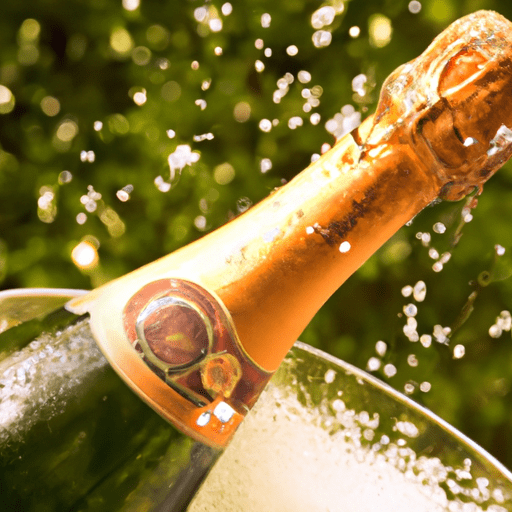The Sparkling Elixir: Exploring the Delightful World of Champagne
If there’s one beverage that has been synonymous with grand celebrations and moments of joy, it’s champagne. This effervescent elixir has not only captivated our hearts but has also found its way into the culinary world, adding a touch of elegance and luxury to a wide array of dishes. From its distinctive taste and versatility in cooking to its intriguing history, we delve into the fascinating world of champagne.
Taste and Aroma: A Burst of Bubbles
Champagne is truly a sensory delight. With its signature bubbles and exquisite taste, it possesses a unique flavor profile that sets it apart from other sparkling wines. The crispness of champagne combines with the perfect balance of sweetness and acidity, creating a refreshing and vibrant experience on the palate. Notes of citrus, apple, pear, and sometimes yeasty undertones dance harmoniously in each sip, making it a truly delightful experience for the taste buds.
Cooking with Champagne: Adding Sparkles to Culinary Creations
While champagne is often celebrated as a standalone celebratory drink, its culinary applications should not be overlooked. This sparkling gem can elevate a wide range of dishes, both savory and sweet, by imparting a touch of elegance and complexity.
Savory Delights:
- Champagne Risotto: By substituting white wine with champagne in a classic risotto recipe, you infuse the dish with a subtle effervescence and a delightful floral note, elevating it to new heights.
- Champagne Reduction Sauce: A reduction made with champagne adds a touch of sophistication to seafood dishes like scallops or lobster, amplifying their flavors and creating a luxurious dining experience.
- Champagne Vinaigrette: Combine champagne with Dijon mustard, olive oil, and herbs to create a light and tangy vinaigrette, perfect for dressing salads, roasted vegetables, or even drizzling over freshly grilled seafood.
Sweet Indulgences:
- Champagne Macarons: Infusing delicate macaron shells with champagne and filling them with champagne-flavored buttercream creates a truly exquisite treat that embodies both elegance and decadence.
- Champagne Poached Pears: Poaching pears in a mixture of champagne, sugar, and spices imparts a subtle effervescence and delicate floral notes, turning this simple fruit into an elegant and sophisticated dessert.
- Champagne Jelly: Combine champagne with gelatin, sugar, and fruit for a delightful and refreshing jelly that can be enjoyed on its own or as a topping for cakes and pastries.
Nutritional Value: A Touch of Health in Every Sip
Beyond its irresistible taste and culinary allure, champagne also offers certain health benefits that make it all the more enticing. While it should be enjoyed in moderation, champagne contains fewer calories and carbohydrates compared to other alcoholic beverages, making it a relatively lighter choice. Additionally, champagne is rich in antioxidants, such as polyphenols, which are known for their potential role in promoting heart health.
History and Interesting Facts: Bubbles with a Story
The story of champagne is intertwined with fascinating tales of innovation and luxury. Dating back to the 17th century, this exquisite beverage originated in the Champagne region of France. Its effervescence was initially considered a flaw, but creative winemakers found ways to embrace and enhance the bubbles. Dom Pérignon, a Benedictine monk, played a pivotal role in perfecting the production process and refining the art of champagne making.
Here are a few interesting facts about champagne:
- Champagne can only be called “champagne” if it comes from the Champagne region in France. Otherwise, it is referred to as sparkling wine.
- The pressure inside a bottle of champagne can reach up to 90 pounds per square inch, making the iconic pop sound when uncorked.
- The Grand Champagne Corking Championships are held annually in France, showcasing the skill and precision required to gracefully open a bottle of champagne.
Whether you’re toasting to a special occasion or seeking to enhance your culinary creations, champagne has a way of elevating moments and dishes with its effervescent charm. From its distinctive taste and culinary versatility to its intriguing history and delightful bubbles, this sparkling elixir continues to mesmerize and delight our senses in countless ways. So, go ahead, raise a glass, and savor the magic of champagne! Cheers! 🥂
Origin of Champagne:
- Champagne is a sparkling wine that originated in the Champagne region of northeastern France.
- The region’s unique cool climate, chalky soil, and specific grape varieties contribute to the distinctive characteristics of Champagne.
Common Uses of Champagne:
- Champagne is commonly enjoyed as a celebratory drink. It is often used to mark special occasions like weddings, anniversaries, and New Year’s Eve celebrations.
- It is also used in cocktails such as the classic “Champagne cocktail” and the popular “Mimosa” which combines Champagne with orange juice.
Nutritional Benefits of Champagne:
- Champagne is relatively low in calories when compared to other alcoholic beverages. In a typical 4 oz (120 ml) glass, there are approximately 90-100 calories.
- It is also gluten-free, as it is made from grapes rather than grains.
Unique Properties and Historical Significance of Champagne:
- Champagne is renowned for its effervescence, which is a result of the secondary fermentation that takes place in the bottle.
- The pressure inside a bottle of Champagne is around 5-6 atmospheres, about three times the pressure in car tires.
- The “Méthode Champenoise” or “Traditional Method” used to produce Champagne involves a complex process of fermentation, aging, blending, and disgorgement.
- Champagne has played a significant role in various historical events, such as being the preferred drink of French kings and the symbolic beverage of celebration.
- The Champagne region was the first to implement strict regulations to protect the integrity of its wines, leading to the creation of the Appellation d’Origine Contrôlée (AOC) system in the early 20th century.




Use the share button below if you liked it.
It makes me smile, when I see it.